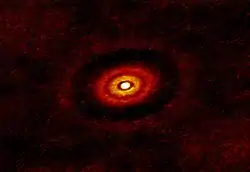CI Tauri
CI Tauri is a young star, about 2 million years old, located approximately 500 light years away in the constellation Taurus. It is still accreting a material from debris disk at unsteady pace possibly modulated by the eccentric[3] orbital motion of the inner planet.[4] The spectral signatures of compounds of sulfur were detected from the disk.[5]
| Observation data Epoch J2000 Equinox J2000 | |
|---|---|
| Constellation | Taurus |
| Right ascension | 04h 33m 52.01444s[1] |
| Declination | +22° 50′ 30.0937″[1] |
| Apparent magnitude (V) | 13.8[1] |
| Characteristics | |
| Evolutionary stage | T Tauri star |
| Spectral type | K4IVe [1] |
| Variable type | Orion variable |
| Astrometry | |
| Radial velocity (Rv) | +16.2[1] km/s |
| Proper motion (μ) | RA: +8.904[1] mas/yr Dec.: –17.067[1] mas/yr |
| Parallax (π) | 6.3008 ± 0.473[1] mas |
| Distance | 520 ± 40 ly (160 ± 10 pc) |
| Details | |
| Mass | 0.80 ± 0.02[2] M☉ |
| Age | .0020[2] Gyr |
| Other designations | |
CI Tau, 2MASS J04335200+2250301, EPIC 247584113[1] | |
| Database references | |
| SIMBAD | data |
The magnetic field on surface of CI Tauri, equal to 0.22 T, is close to average for T Tauri stars.[6]
Planetary system
In 2016 a planet, CI Tauri b, was discovered orbiting CI Tauri on a very tight yet eccentric 9-day orbit.[2]
The discovery of CI Tauri b was notable because it is a hot Jupiter, which are supposed to take a minimum of 10 million years to form, and are often thought to be too close to their parent stars to have formed there.[7][8]
The spectral signature of the carbon monoxide attributed to the atmosphere of the CI Tauri b was detected in 2019.[9]
| Companion (in order from star) |
Mass | Semimajor axis (AU) |
Orbital period (days) |
Eccentricity | Inclination | Radius |
|---|---|---|---|---|---|---|
| b | 11.6+2.9 −2.7 MJ |
— | 8.9891±0.0202 | 0.25±0.16 | — | — |
| c[10] (unconfirmed) | 0.525±0.275 MJ | 104.5±1.6 | — | — | — | — |
| d (Unconfirmed) | — | — | — | — | — | — |
| e (Unconfirmed) | — | — | — | — | — | — |
| debris disk[5] | 200–600 AU | 50.3° | — | |||
Additional planets suspected
In 2018 the possible detection of three more planets (inferred by gaps in the protoplanetary disk surrounding the star) was announced. Using the Atacama Large Millimeter Array (ALMA) to look for 'siblings' of CI Tauri b, a team of researchers detected three distinct gaps in the protoplanetary disk which their theoretical modelling suggests are caused by three other planets. The two outer planets are believed to be about the mass of Saturn, while the inner planet's mass is around the same as CI Tauri b.[8] Two of the new planets are similarly located to those inferred in the HL Tauri protoplanetary disk.[11]
If this discovery is confirmed this would be the most massive collection of exoplanets ever detected at this age with its four planets spanning a factor of a thousand in orbital radius.[11]
The gaps are visible in the wideband photography, but not in the gas spectral lines. These "gaps" may be a lower-temperature shadows of dust in inner disk cast on outer parts rather than true gaps carved by planets.[12]
References
- "V* CI Tau -- T Tau-type Star". SIMBAD. Retrieved 19 October 2018.
- "CI Tau". Open Exoplanet Catalogue. Retrieved 20 October 2018.
- Lai, Dong; Teyssandier, Jean (2020). "Pulsed Disc Accretion Driven by Hot Jupiters". Monthly Notices of the Royal Astronomical Society. 495 (4): 3920–3928. arXiv:1911.08492. Bibcode:2020MNRAS.495.3920T. doi:10.1093/mnras/staa1363. S2CID 208175992.
- Biddle, Lauren I.; Johns-Krull, Christopher M.; Llama, Joe; Prato, Lisa; Skiff, Brian A. (2018). "K2 reveals pulsed accretion driven by the 2 Myr old hot Jupiter CI Tau b". The Astrophysical Journal. 853 (2): L34. arXiv:1801.06234. Bibcode:2018ApJ...853L..34B. doi:10.3847/2041-8213/aaa897. S2CID 111379078.
- Le Gal, Romane; Öberg, Karin I.; Loomis, Ryan A.; Pegues, Jamila; Bergner, Jennifer B. (2019). "Sulfur chemistry in protoplanetary disks: CS and H2CS". The Astrophysical Journal. 876 (1): 72. arXiv:1903.11105. Bibcode:2019ApJ...876...72L. doi:10.3847/1538-4357/ab1416. S2CID 85528537.
- Sokal, Kimberly R.; Johns-Krull, Christopher M.; Mace, Gregory N.; Nofi, Larissa; Prato, L.; Lee, Jae-Joon; Jaffe, Daniel T. (2020). "The Mean Magnetic Field Strength of CI Tau". The Astrophysical Journal. 888 (2): 116. arXiv:1911.00784. Bibcode:2020ApJ...888..116S. doi:10.3847/1538-4357/ab59d8. S2CID 207870483.
- "Astronomers find giant planet around very young star CI Tauri". Astronomy Now. Retrieved 20 October 2018.
- "Giant planets around young star raise questions about how planets form". University of Cambridge. 2018-10-15. Retrieved 20 October 2018.
- Flagg, Laura; Johns-Krull, Christopher M.; Nofi, Larissa; Llama, Joe; Prato, L.; Sullivan, Kendall; Jaffe, D. T.; Mace, Gregory (2019). "CO Detected in CI Tau b: Hot Start Implied by Planet Mass and MK". The Astrophysical Journal. 878 (2): L37. arXiv:1906.02860. Bibcode:2019ApJ...878L..37F. doi:10.3847/2041-8213/ab276d. S2CID 174801528.
- Konishi, Mihoko; Hashimoto, Jun; Hori, Yasunori (2018). "Probing Signatures of a Distant Planet around the Young T-Tauri Star CI Tau Hosting a Possible Hot Jupiter". The Astrophysical Journal. 859 (2): L28. arXiv:1805.07498. Bibcode:2018ApJ...859L..28K. doi:10.3847/2041-8213/aac6d2. S2CID 119208569.
- Clarke, Cathie J; Tazzari, Marco; Juhasz, Attila; Rosotti, Giovanni; Booth, Richard; Facchini, Stefano; Ilee, John D; Johns-Krull, Christopher M; Kama, Mihkel; Meru, Farzana; Prato, Lisa (2018). "High resolution millimetre imaging of the CI Tau protoplanetary disc - a massive ensemble of protoplanets from 0.1 - 100 au". The Astrophysical Journal. 866: L6. arXiv:1809.08147. doi:10.3847/2041-8213/aae36b. S2CID 119042020.
- Rosotti, Giovanni P.; Ilee, John D.; Facchini, Stefano; Tazzari, Marco; Booth, Richard A.; Clarke, Cathie; Kama, Mihkel (2020). "High resolution observations of molecular emission lines toward the CI Tau proto-planetary disc: planet-carved gaps or shadowing?". Monthly Notices of the Royal Astronomical Society. arXiv:2012.07848. Bibcode:2020MNRAS.tmp.3654R. doi:10.1093/mnras/staa3869. S2CID 229180958.
